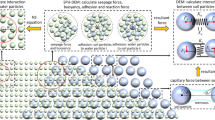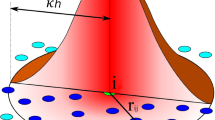Abstract
For seepage failures of dike due to water level-up and rainfall, surface infiltration and strength change induced by suction reduction are important factors; thus, numerical analysis should consider the coupling of water and soil, as well as the effect of saturation to obtain more precise failure mechanism. Based on the advanced smoothed particle hydrodynamics (SPH) method, this work proposed a two-phase-coupled SPH model in coordination with a novel constitutive model for unsaturated soils. Then, a triaxial compression test is simulated to check the applicability of the SPH method on the soil phase. After that, the failure test of a dike due to water level-up is discretized and simulated, from which the seepage process, the distribution of maximum shear strain, the slip surface, and pore water pressure are obtained. The two-phase-coupled SPH model is also applied to a slope failure test of heavy rainfall, and the results are compared to the model test. Finally, a dike failure test due to rainfall is analyzed using the proposed SPH model to reproduce the surface infiltration and suction reduction. The proposed SPH model provides several insights of seepage failures and can be a helpful tool for the analysis of dike failures induced by water level-up and rainfall.
























Similar content being viewed by others
References
Batchelor GK (2000) An introduction to fluid dynamics. Cambridge University Press, Cambridge
Biot MA (1941) General theory of three-dimensional consolidation. J Appl Phys 12(2):155–164
Bui HH, Fukagawa R (2013) An improved SPH method for saturated soils and its application to investigate the mechanisms of embankment failure: case of hydrostatic pore-water pressure. Int J Numer Anal Meth Geomech 37(1):31–50
Cascini L, Cuomo S, Pastor M, Sorbino G (2010) Modelling of rainfall-induced shallow landslides of the flow-type. J Geotech Geoenviron Eng 136(1):85–98
Collins BD, Znidarcic D (2004) Stability analyses of rainfall induced landslides. J Geotech Geoenviron Eng 130(4):362–372
Cui YJ, Delage P (1996) Yielding and plastic behavior of an unsaturated compacted silt. Geotechnique 46(2):291–311
Foote GB, Toit PSD (1969) Terminal velocity of raindrops aloft. J Appl Meteorol 8(1969):249–253
Gray JP, Monaghan JJ, Swift RP (2001) SPH elastic dynamics. Comput Methods Appl Mech Eng 190(49–50):6641–6662
Huang Y, Zhang W, Xu Q, Xie P, Hao L (2012) Run-out analysis of flow-like landslides triggered by the Ms 8.0 2008 Wenchuan earthquake using smoothed particle hydrodynamics. Landslides 9(2):275–283
Huang Y, Zhang WJ, Dai ZL, Xu Q (2013) Numerical simulation of flow processes in liquefied soils using a soil–water-coupled smoothed particle hydro-dynamics method. Nat Hazards 69(1):809–827
Kutanaei SS, Choobbasti AJ (2015) Mesh-free modeling of liquefaction around a pipeline under the influence of trench layer. Acta Geotech 10(3):343–355
Liu GR, Liu MB (2003) Smoothed particle hydro-dynamics: a mesh-free particle method. World Scientific Press, Singapore
Liu MB, Liu GR (2010) Smoothed particle hydrodynamics (SPH): an overview and recent developments. Arch Comput Methods Eng 17(1):25–76
Maeda K, Sakai H (2010) Seepage failure and erosion of ground with air bubble dynamics. In: Proceedings of GeoShanghai Jun 2010, Shanghai, China, Geoenvironmental engineering and geotechnics (Geotechnical Special Publication No. 204), pp 261–266
Mast CM, Arduino P, Mackenzie-Helnwein P, Miller GR (2015) Simulating granular column collapse using the material point method. Acta Geotech 10(1):101–116
Mergili M, Moreiras SM, Fellin W, Stötter J (2007) Preliminary results of slope stability simulations for the prediction of debris flows in the Central Andes (Mendoza, Argentina). In: Proceedings of geomorphology for the future, Sep 2–7 2007, Obergurgl, Austria, pp 145–152
Morris JP, Fox PJ, Zhu Y (1997) Modeling low Reynolds number incompressible flows using SPH. J Comput Phys 136(1):214–226
Pastor M, Hadda B, Sorbino G, Cuomo S, Drempetic V (2009) A depth-integrated, coupled SPH model for flow-like landslides and related phenomena. Int J Numer Anal Meth Geomech 33(2):143–172
Peng C, Wu W, Yu HS, Wang C (2015) A SPH approach for large deformation analysis with hypoplastic constitutive model. Acta Geotech 10(6):703–717
Takeda H, Miyama M, Sekiya M (1994) Numerical simulation of viscous flow by smoothed particles hydrodynamics. Prog Theor Phys 92(5):939–960
Vignjevic R, Campbell J, Libersky L (2000) A treatment of zero-energy modes in the smoothed particle hydrodynamics method. Comput Method Appl Mech Eng 184(1):67–85
Xiong YL, Bao XH, Ye B, Zhang F (2014) Soil–water–air fully coupling finite element analysis of slope failure in unsaturated ground. Soils Found 54(3):377–395
Zhang F, Ikariya T (2011) A new model for unsaturated soil using skeleton stress and degree of saturation as state variables. Soils Found 51(1):67–81
Zhang WJ, Maeda K (2014) The model test and SPH simulations for slope and levee failure under heavy rainfall considering the coupling of soil, water and air. In: Proceedings of GeoShanghai May 2014, Shanghai, China, Soil behavior and geomechanics (Geotechnical Special Publication No. 236), pp 538–547
Zhang WJ, Maeda K (2015). Numerical simulations of slope and levee failure under heavy rainfall using the three-phase SPH model. J Jpn Soc Civ Eng Ser A2 (Appl Mech [AM]) 70(2):483–494
Zhang F, Xiong YL, Zhang S, Ye B (2014) Thermo-hydro-mechanical-air coupling finite element method and its application to multi-phase problems. J Rock Mech Geotech Eng 6(2):77–98
Acknowledgments
The authors are grateful to the Japan Society for the Promotion of Science for its financial support with Grants-in-Aid-for Scientific Research (B) 26289152. The revision of this work is supported by “the Fundamental Research Funds for the Central Universities, China” No. 2016B01314.
Author information
Authors and Affiliations
Corresponding author
Rights and permissions
About this article
Cite this article
Zhang, W., Maeda, K., Saito, H. et al. Numerical analysis on seepage failures of dike due to water level-up and rainfall using a water–soil-coupled smoothed particle hydrodynamics model. Acta Geotech. 11, 1401–1418 (2016). https://doi.org/10.1007/s11440-016-0488-y
Received:
Accepted:
Published:
Issue Date:
DOI: https://doi.org/10.1007/s11440-016-0488-y




